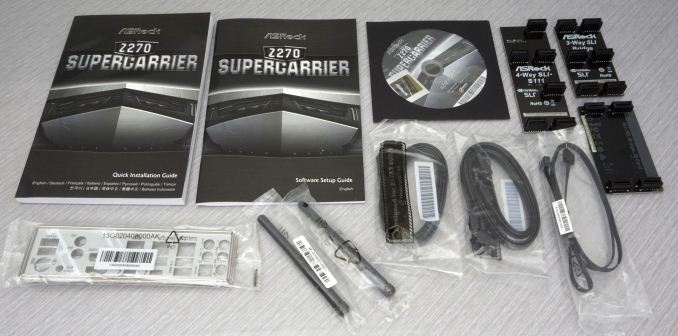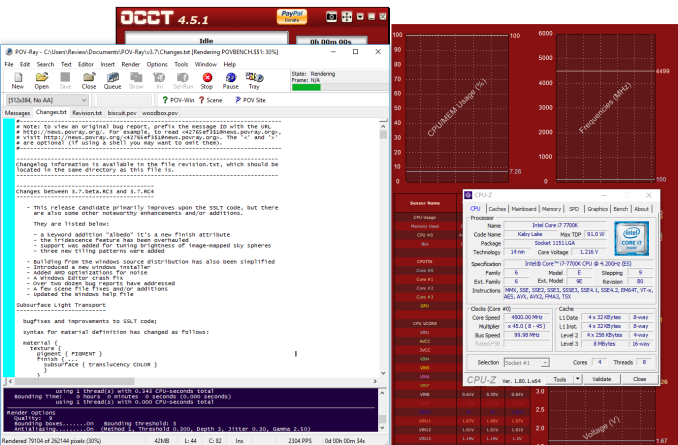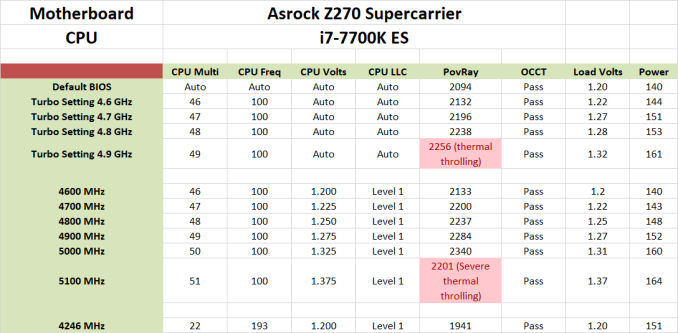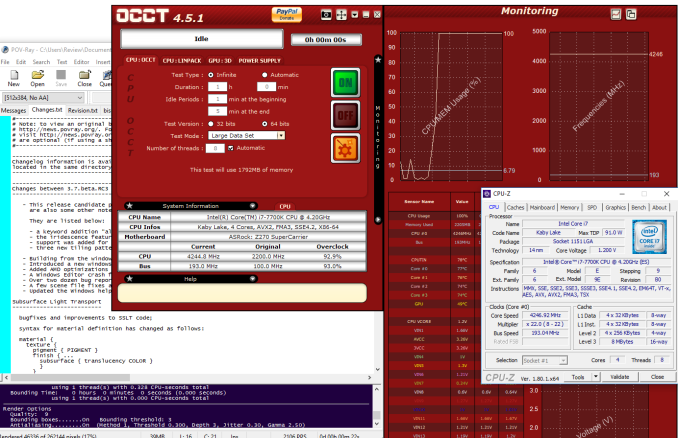The ASRock Z270 Supercarrier Motherboard Review: 4-way SLI and 5 Gigabit Ethernet on Kaby Lake
by E. Fylladitakis on September 29, 2017 9:00 AM EST- Posted in
- Motherboards
- ASRock
- SLI
- Aquantia
- Z270
ASRock Z270 Supercarrier Board Features
A quick look at ASRock’s website easily reveals that they intended the Z270 Supercarrier to be for professional designers and content editors. That, however, is a very narrow segment of the market, so the company’s engineers tried to add features that would also entice gamers and enthusiasts with larger budgets. The main highlight of the Z270 Supercarrier is the presence of four PCIe ×8 slots that allow for triple and quad SLI configurations, for either productivity or gaming. Other than that, ASRock has also added a very powerful CPU circuitry and advanced controllers that would appeal to gamers, as well as extensive storage device support that is needed by professionals. Despite the sheer number of features and supported devices, the dimensions of the Z270 Supercarrier are those of a standard ATX motherboard, ensuring compatibility with a far greater number of PC cases over an E-ATX design.
| ASRock Z270 Supercarrier | |
| Warranty Period | 3 Years |
| Product Page | Link |
| Price | Link |
| Size | ATX |
| CPU Interface | LGA1151 |
| Chipset | Intel Z270 |
| Memory Slots (DDR4) | Four DDR4 Supporting 64GB Dual Channel Up to DDR4-3733+ |
| Memory Slots (DDR3L) | None |
| Video Outputs | HDMI 1.4a DisplayPort 1.2 |
| Network Connectivity | AQC108 / Intel I219-V / Intel I211-AT |
| Onboard Audio | Realtek ALC1220 |
| PCIe Slots for Graphics (from CPU) | 4 × PCIe 3.0 via PEX 8747 (×16/×16, ×16/×8/×8, ×8/×8/×8/×8) |
| PCIe Slots for Other (from PCH) | 1 × PCIe ×1 |
| Onboard SATA | Six, RAID 0/1/5/10 |
| Onboard SATA Express | Two |
| Onboard M.2 | 3 × PCIe 3.0 (x4) |
| Onboard U.2 | None |
| USB 3.1 | Two Type-C (Intel JHL6540) |
| USB 3.0 | 4 x Type-A Rear Panel 4 × via headers 1 × Type-A onboard |
| USB 2.0 | 2 × Rear Panel 4 × via headers |
| Power Connectors | 1 x 24-pin ATX 1 x 8-pin CPU 1 x 6-pin GPU |
| Fan Headers | 1 x CPU (4-pin) 1 x Pump/Aux (4-pin) 3 x System (4-pin) |
| IO Panel | 4 x USB 3.0 (USB 3.1 Gen 1) 2 x USB 2.0 2 x USB 3.1 Type-C/Thunderbolt 3 1 x CMOS Reset Button 3 x Network RJ-45 1 x DisplayPort 1.2 1 x HDMI 1.4a 1 x Combo PS/2 5 x 3.5 mm Audio Jacks 1 x Optical SPDIF Out Port |
| Other Features | WiFi/BT Onboard Supports Intel® Optane™ technology Front Audio Header w/ TI NE5532 amplifier COM port header RGB lighting Dual LAN with Teaming |
In The Box
We get the following:
- Driver Disk
- Quick Installation Guide
- Software Setup Guide
- Rear I/O Shield
- Four black SATA cables (two straight, two with a 90° connector)
- SLI HB bridges (2-way, 3-way, and 4-way)
- RGB strip cable
- Wireless antennas
- Case badge
The items bundled alongside with the Z270 Supercarrier begin with a standard manual, a drivers/software DVD, a metallic I/O shield, a case badge, and four SATA cables; ordinary items that can be found accompanying almost any motherboard. However, we also find an extra cable for external RGB strips, two wireless antennas, and three HB SLI bridges. The HB SLI bridges are specially designed so as to support the NVIDIA GTX 1080 GPUs. However, we found the inclusion of typical antennas strange, as they often are the cause of space issues behind a case. A single wired antenna such as the one ASRock supplies with the Z270 Gaming-ITX/ac would have been much more convenient.
ASRock Z270 Supercarrier Overclocking
Experience with ASRock Z270 Supercarrier
Although the main target group of the Z270 Supercarrier are professionals, most of which are unlikely to do any overclocking at all, ASRock included a wealth of overclocking options and advanced circuitry to support it. This was probably an effort to make the Z270 Supercarrier a competitive option for enthusiastic gamers with large budgets. No matter the reason, the Z270 Supercarrier does have both the hardware and the software to support extensive overclocking. The power circuitry is excellent and the BIOS is very flexible, with the voltage and frequency options having excellent range and step.
Methodology
Our standard overclocking methodology is as follows. We select the automatic overclock options and test for stability with PovRay and OCCT to simulate high-end workloads. These stability tests aim to catch any immediate causes for memory or CPU errors.
For manual overclocks, based on the information gathered from previous testing, starts off at a nominal voltage and CPU multiplier, and the multiplier is increased until the stability tests are failed. The CPU voltage is increased gradually until the stability tests are passed, and the process repeated until the motherboard reduces the multiplier automatically (due to safety protocol) or the CPU temperature reaches a stupidly high level (100ºC+). Our test bed is not in a case, which should push overclocks higher with fresher (cooler) air.
Overclock Results
At this point we should again mention that the ASRock Z270 Supercarrier has multi-core turbo enabled by default, which is common, but also has a default turbo multiplier of ×45 rather than ×44, essentially overclocking our 7700K CPU to 4.5 GHz by default.
Testing the automated overclock options proved that ASRock’s overclocking presets will work fine for users that do not want to concern themselves with detailed settings. The automated setting however are, as expected, a little too generous with the voltage. Our system was working fine with the Turbo CPU setting up to 4.8 GHz but any further than that would raise our processor’s temperatures too high and trigger thermal throttling. Better cooling solutions and a lucky CPU pick can yield much better overclocking results if done manually. Manual control allowed us to reach a fully stable overclock of 5.0 GHz. Ultimately, what limited us was the thermal performance of our CPU and not the motherboard.
The ASRock Z270 Supercarrier also handles high BCLK frequencies very well. We managed to reach a fully stable frequency of 193 MHz with virtually minimal tweaking. Note that the newer motherboard designs decouple the CPU bus from the rest of the frequency domains in order to allow for these high BCLK overclocks, meaning that the performance of other components and the system’s overall bandwidth remains unaffected. On the contrary, frequency misalignments can cause an overall performance drop. Thus, this technique is useless to users who have unlocked CPUs and should be used only to overclock locked CPUs.














50 Comments
View All Comments
Dr. Swag - Friday, September 29, 2017 - link
You guys are reviewing so many z270 boards all of a sudden, but it feels a bit like a waste with z370 just around the corner, just saying.shabby - Friday, September 29, 2017 - link
Ya it's kinda funny how the z270 I'll suffer eof so quickly... classic intel.shabby - Friday, September 29, 2017 - link
Derp eolddriver - Friday, September 29, 2017 - link
It has 5 gbit lan... cuz the poor platform doesn't have enough lanes to drive more...Timing is understandable, orders from intel hq came to push as much eol products as possible now, because pretty soon they will sell at a significant discount.
saratoga4 - Saturday, September 30, 2017 - link
DMI 3.0 is 32 GBit/s, so 5Gbit ethernet can easily go on the chipset PCIe switch. Which goes to show just how far behind everything else wired ethernet has fallen.Wwhat - Thursday, October 5, 2017 - link
You are right, the tech world really needs to massively go to higher because 1gb internet is all over the place now and they can't go higher because the average consumer would have issues plugging that into existing networking equipment.I suppose they could include a modem with USB-C connector instead of LAN, but you can't assume every USB-C device actually has USB3.0 or higher speeds, sigh.
Plus many want their own router so it would be nice if routers on the market now were a bit forwards looking and did more than 1gbit.
And meanwhile LTE and such reach 1gbit when in fact data prices are such that Joe Average has no use for more than 50mbit or so.
The whole thing seems poorly thought out.
Notmyusualid - Sunday, October 8, 2017 - link
More 'ddriver BS' - 5Gb/s LAN is seen as a cost-effective alternative to 10Gb/s NICs, that are still expensive to buy / implement.There is tons more connectivity from the DMI than is required by all the NICs on this board - as stated by others.
Please seek professional psychological help.
SharpEars - Friday, September 29, 2017 - link
That's right, I want to invest >$200 in a soon to be obsolete motherboard.Gothmoth - Friday, September 29, 2017 - link
you may not but anandtech likes to get all this intel money they spend on PR.Morawka - Friday, September 29, 2017 - link
Hey i just sold my z89 Asus Maximus VI Extreme motherboard on ebay for $300, it's not that far of a stretch. a man needs what a man needs.